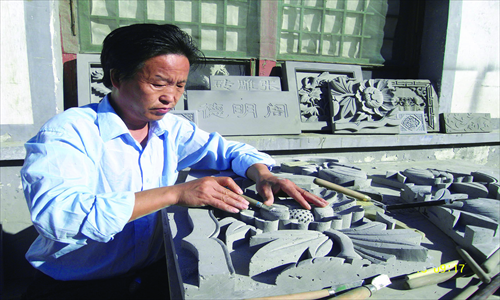Carving out a place in history: tile carvers put traditional craftsmanship first

With a chisel in his right hand and a hammer in his left, Zhang Yan is hard at work in his Shunyi district studio. Alongside him, working on the same two-square-meter sculpture of smoothed brick, are his apprentices. On the cool bricks lie their instruments: knives, chisels and brushes. Nearby in the 20-square-meter room are their beautiful finished tile works, all made by hand.
As the sixth-generation decedent of the Zhang family of tile-carving craftsmen, the 48-year-old Zhang said he enjoys working on this technique that has been passed down from generation to generation since the 18th century.
"The best time was the second and the third generation [of the Zhang family], when it was the thriving period of the Qing Dynasty (1644-1911). They were the craftsmen employed by the royal court," Zhang said.
Tile carving can be seen at the gates and ridges of courtyards and hutong within the Second Ring Road of Beijing, where old Beijing used to be. You can also find the intricate tile work at Beijing's imperial palaces and temples.
Decorative history
"Unlike the tile carving in southern China which focused on people's portraits or storytelling, Beijing's tile carving features mostly flowers, mountains and rivers which implicate auspicious connotations," said Ma Bingjian, director of the Beijing Ancient Architectural Design Institute.
Different designs of tile carving indicate different identities and wishes of the residents within.
For instance, the most popular design, a tree peony, is associated with great fortune and is usually requested by businesspeople hoping to increase their wealth.
Pine trees, bamboo and plum blossoms are the most common designs for scholars because they are symbols of integrity for the literati. From the different designs of the tile carving on the house, you can tell the general status and pursuits of the house owner.
Due to the stable nature of bricks, tile carvings have been found intact in tombs from ancient times.
But tile art became a common decoration for residential houses during the Ming Dynasty (1368-1644). The tile carving decorations for residential houses that still exist now in Beijing are mostly from the Qing Dynasty.
When the Qing, the last feudal dynasty, was overthrown, the tile-carving craftsmen, who were all employed by the court, were laid off.
A family affair
The Zhang family stuck with the family tradition. Learning the craft from his father since the age of 8, Zhang is the only descendent who still upholds the pure, handmade carving craft just like Zhangs of generations past.
He believes that making the tiles by hand is what makes his work unique. Other tile carvings producers use machine batch production to turn out tiles on a larger scale.
In order to pass on this traditional art form, Zhang recruited 20 apprentices, many of whom have been learning from Zhang for years.
"It takes three years to become a junior tile-carving craftsman, but to be a senior one, one has to practice for more than 10 years," said Zhang.
A painstaking process
Zhang said that a tile-carving craftsman needs to have patience, a basic knowledge of drawing and a deep love for the craft.
Zhang explained the basic steps of tile carving: first, he picks a brick that is whole and has no cracks. He smoothes the surface of it, chops it into a suitable size and draws the design on the brick. Then he uses a chisel to roughly sketch the desired picture onto the brick.
From there, it's just a mater of further refining the design, then using some special glue to stuff the holes on the surface of the carving. The gluing step is the most crucial - it will make or break the vividness and charm of the carving.
Along with courtyard houses, tile carving has become part of the city's treasured history and has shifted from an underappreciated sight to a key cultural artifact worthy of recognition and, most importantly, preservation.
Modern recognition
Many people started to take notice of this traditional art form when Zhang was requested to carve tile walls for the 2008 Beijing Olympic Village.
In 2009, Beijing's tile carving craftsmanship made it onto the Intangible Cultural Heritage Protection list.
"Many of my customers buy my works to decorate the walls of their traditional, Chinese-style villas or scenic spots. Some of them also give the smaller carved tile pieces to their friends as gifts," said Zhang. "Now is also a good time for tile carving, because of people's increasing interest in traditional Chinese culture."
The new reverence for old traditions has helped Zhang's tile business. The average price for a one-square-meter handmade tile carving from Zhang is about 3,000 yuan ($482).
His handcrafted works now have a certain cultural cache that makes people eager to get on his waiting list.
"I receive more than a dozen orders every day. Every order takes, on average, 30 days, so my customers are lining up to purchase my work," Zhang said. "Some of them even have to wait for years."